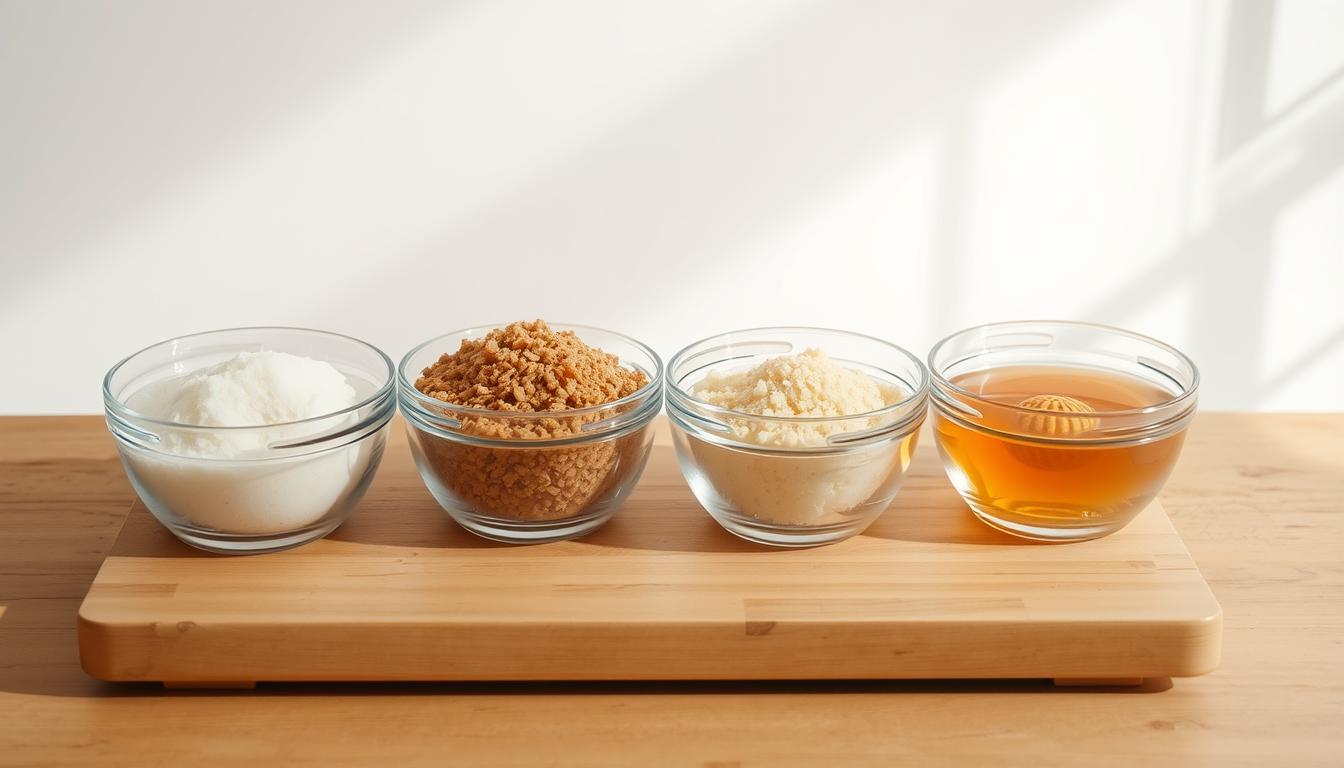Did you know your sandwich loaf contains just 1/3 teaspoon of sugar per slice? That tiny amount shapes everything from crust color to shelf life. While most bakers focus on flour or yeast, sweeteners play a critical—and often misunderstood—role in fermentation.
Sweeteners act as yeast fuel and moisture regulators. Lower quantities create vigorous rises by letting microorganisms thrive, while excess amounts slow them down. This balancing act determines whether your dough overproofs or achieves perfect spring.
Honey, brown sugar, and alternatives like maple syrup each alter fermentation speed. Their unique water-binding capacities affect crumb softness days after baking. Even sugar-free recipes rely on this chemistry—reducing sweetness impacts flavor far more than structure in yeast-raised goods.
Key Takeaways
- Sweetener quantity directly controls rising speed and dough elasticity
- All sugars extend freshness by preventing moisture loss during baking
- Concentrations above 10% of flour weight dominate flavor profiles
- Natural sweeteners like honey accelerate fermentation compared to white sugar
- Reduced-sugar doughs require longer proofing times for proper development
Understanding the Science Behind Sugar in Yeast Bread Proofing

Have you ever wondered why some doughs rise faster than others? The answer lies in how yeast interacts with sugars. These microorganisms feast on both added sweeteners and natural starches in flour, producing carbon dioxide and ethanol as byproducts. This gas forms bubbles that lift your dough—a process that accelerates when sugar is present.
How Sugar Energizes Yeast
Active dry yeast doesn’t need added sugar to survive, but it thrives with it. Think of sugar as instant fuel: it kickstarts fermentation before yeast breaks down complex starches. Harold McGee’s research confirms this—moderate amounts boost activity by 30% compared to sugar-free environments.
Too much sugar backfires, though. When concentrations exceed 10% of flour weight (using baker’s percentage), osmotic pressure dehydrates yeast cells. This slows fermentation—a critical factor when working with enriched doughs.
The Role of Baker’s Percentage
This calculation method helps predict outcomes. Divide sugar weight by flour weight to get your percentage:
- Below 10%: Enhances flavor subtly
- Above 10%: Requires adjusted proofing times
Simple sugars like glucose feed yeast faster than sucrose. That’s why honey-fermented doughs rise quicker than those with table sugar. Balancing these factors ensures consistent results whether you’re using a teaspoon sugar or experimenting with alternatives.
Bread Proofing with Different Sugars: Best Practices and Techniques
What separates a dense brick from an airy loaf? Often, it’s how you handle sweeteners during fermentation. Proper timing and selection create the perfect balance between yeast activity and dough structure.

When to Add Sugar in Your Recipe
Test your active dry yeast by mixing ¼ teaspoon sugar with warm water. If bubbles form within 10-15 minutes, your yeast is alive. This trick prevents failed rises before starting your bread recipe.
Add sugar early when making enriched doughs. For lean doughs, incorporate it during mixing. Immediate addition speeds initial fermentation, while delayed integration extends rising times for complex flavors.
Choosing the Right Type of Sugar
Liquid sweeteners like honey hydrate bread dough but slow initial activity. Granulated sugars provide instant energy. Consider these factors:
| Sugar Type | Proofing Speed | Flavor Impact | Moisture Contribution |
|---|---|---|---|
| White Sugar | Fast | Neutral | Low |
| Honey | Medium | Floral | High |
| Maple Syrup | Slow | Earthy | Medium |
| Coconut Sugar | Very Slow | Caramel | Low |
Share your sugar-swap successes on LinkedIn using #BreadScience. Experimentation helps perfect your recipe while understanding each sweetener’s unique fermentation profile.
Creating the Ideal Proofing Environment
Your dough’s rise depends as much on surroundings as ingredients. Even slight temperature shifts alter fermentation speed, while air exposure creates surface tension that limits expansion.

Optimal Temperature and Humidity Settings
Maintain 72°F to 78°F for steady yeast activity. Warmer spots accelerate gas production but risk overproofing. Cooler areas slow fermentation, deepening flavor complexity.
Place your bowl near radiators or inside an oven with only the light on. Digital thermometers help track fluctuations. Doughs with higher sugar content often need 2-3°F warmer settings to counter moisture-binding effects.
Covering and Storing Your Dough
Skip tea towels—they let moisture escape. Use airtight lids or plastic wrap instead. This traps humidity, preventing skin formation that restricts rising.
Choose containers allowing 50% expansion. For multi-hour proofs, lightly oil surfaces to maintain elasticity. Share your perfected setup using #BakingHacks on social platforms.
Adjusting Sugar Levels for Flavor and Texture in Your Bread
Mastering sugar levels transforms ordinary loaves into bakery-quality creations. The sweetener quantity influences crust development, crumb structure, and shelf life—all while shaping your final product’s personality.
Sweeteners work like flavor amplifiers below 10% of flour weight. At this threshold, they enhance richness without making your yeast bread taste sugary. Think of it as seasoning—a teaspoon sugar boost complements whole wheat’s nuttiness or rye’s earthiness.
Balancing Sweetness with Dough Moisture
Granulated sugars and liquid sweeteners behave differently. White sugar pulls moisture from dough during baking, creating crispier crusts. Honey adds hydration, keeping sandwich bread soft for days.
| Sugar Type | Browning Effect | Moisture Impact | Flavor Role |
|---|---|---|---|
| White Sugar | High | -15% | Neutral enhancer |
| Honey | Medium | +20% | Floral notes |
| Coconut Sugar | Low | -5% | Caramel undertones |
| Maple Syrup | Medium-High | +10% | Woody complexity |
Reduce sweeteners gradually when modifying bread recipes. Cutting 25% at a time maintains structure while exploring flavor boundaries. For crustier results, decrease amounts sugar by 1 tablespoon per loaf.
Share your perfected sandwich loaf variations using #BakeSmart on social platforms. Tag friends who appreciate the science behind golden crusts and tender crumbs.
Conclusion
Did you realize that a single teaspoon can alter your bread’s entire character? While sugar isn’t mandatory for fermentation, it serves as yeast’s turbocharger—accelerating activity while enhancing crust color and crumb softness. Your choice between granulated, liquid, or alternative sweeteners directly shapes fermentation speed and flavor depth.
Remember the 10% rule: crossing this threshold transforms sugar from subtle enhancer to dominant player. For high-sugar doughs, specialized yeasts like SAF Gold outperform standard strains by resisting osmotic stress. This knowledge lets you tweak recipes confidently—reducing sweetness without compromising structure becomes second nature.
Your environment matters as much as ingredients. Maintain precise temperatures and humidity levels to balance yeast metabolism with dough development. Share your perfected classic sandwich loaf variations using #BakeSmart, tagging bakers who appreciate how science elevates everyday staples.
Now armed with these insights, experiment boldly. Whether crafting crusty artisanal rounds or tender sandwich breads, you control the equation—one calculated teaspoon at a time.



